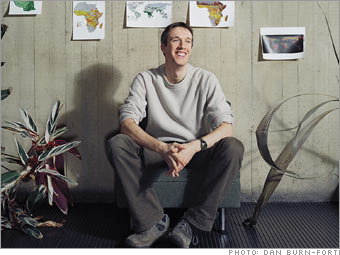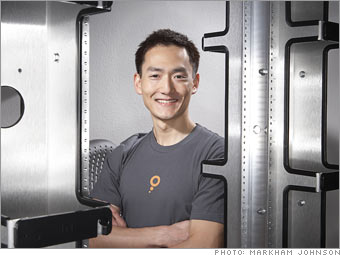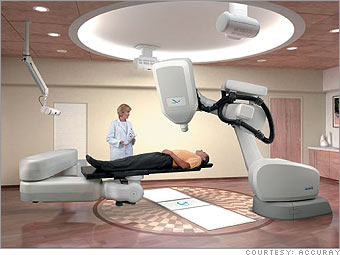Salary range:$40,000-$150,000
Experience/skills: A Ph.D. or master's in a tech field, plus expertise in a particular disease.
Perks: Flexible hours and travel to exotic locales
Who's hiring? Universities, governments, the United Nations, some consultancies
Early in his career, Andy Tatem became so proficient at analyzing fuzzy satellite images of English farms that he could tell wheat cops from turnip fields by studying the way the sun reflected off each.
Experience/skills: A Ph.D. or master's in a tech field, plus expertise in a particular disease.
Perks: Flexible hours and travel to exotic locales
Who's hiring? Universities, governments, the United Nations, some consultancies
Early in his career, Andy Tatem became so proficient at analyzing fuzzy satellite images of English farms that he could tell wheat cops from turnip fields by studying the way the sun reflected off each.

Interesting stuff if you're a farmer, but not sufficiently inspiring for Tatem. Then came a call last year from Simon Hays, an Oxford University researcher who was developing a global map of malaria that could explain current outbreaks and help predict future ones.
Today Tatem, a 29-year-old Ph.D., is among a new class of researchers using the latest satellite imagery, cheap computing, big databases, and free tools like Google Earth to show how epidemics spread around the globe.

Salary range: $40,000-$100,000
Experience/skills: Associate degree in a technical field and extensive training. People skills also come in handy.
Perks: Lots of travel, helping clients customize each machine to a particular task
Who's hiring? ABB, Fanuc, Motoman, Panasonic, Toyota
Back in 1990, Matt Zeigler was pulling 12-hour shifts as an arc welder for a forklift manufacturing firm in Indiana when a technician in a white lab coat came into the factory to work on a new $85,000 robotic welder. "I said, 'Why aren't I doing that?'" Zeigler recalls. Self-training eventually got him out of blue-collar work and into a top robot programming position at Motoman in Dayton, Ohio, one of a growing number of industrial robot manufacturers that train humans to make sure their products perform as advertised.
Industrial robots, once a fixture in the auto industry, now are doing everything from analyzing blood samples to mixing cocktails. The latest innovations include multi-armed robots with vision systems and enough machine intelligence to read labels and pick out the parts they need from nearby bins.
Zeigler, 35, spends most of his time behind a PC and a custom hand-held controller, calibrating the robots' moving parts to be in just the right place at just the right time. He is also on the road a lot, acting as salesman, engineer, and installer for Motoman's customers. "I wear a lot of hats," he says.
Far from eliminating jobs, Zeigler says robots are "creating better jobs and better-paying jobs. They're just more technical and not as repetitive."
3) Information Engineer
Salary range: $70,000-$120,000
Experience/skills: Data analytics, network administrator experience, writing skills
Perks: Stock options, free food
Who's hiring? PayPal, Slide, and other Web 2.0 startups unable to stay on top of the data
Every Sunday the three 20-something founders of Meebo, an instant-messaging startup based in San Francisco, meet to talk strategy and almost always end up wanting new data before making any decision. "We'd walk away wanting to know things like where is our churn rate the greatest, or how are the users in Brazil different from those in India with regard to how they navigate the site," says CEO Seth Sternberg.
So Sternberg created a new position--"information engineer"--dedicated exclusively to digging up the answers. The first person to fill it: Bob Lee, 34, a former network engineer at Apple, who now sits in front of three monitors poring over an estimated 200 gigabytes of data every day from more than 5 million users. It's Lee's job, using a combination of networking chops and statistical analysis, to point out trends, explain network hiccups, and reveal what new features are hits or duds.
Other Web 2.0 companies, like PayPal and Slide, have begun adding similar positions to answer queries that off-the-shelf analytics tools can't handle, such as calculating churn rates. "There's all this data available to help make decisions," Sternberg says. "But it takes someone really focusing on it to get the benefit."
Perks: Stock options, free food
Who's hiring? PayPal, Slide, and other Web 2.0 startups unable to stay on top of the data

Every Sunday the three 20-something founders of Meebo, an instant-messaging startup based in San Francisco, meet to talk strategy and almost always end up wanting new data before making any decision. "We'd walk away wanting to know things like where is our churn rate the greatest, or how are the users in Brazil different from those in India with regard to how they navigate the site," says CEO Seth Sternberg.
So Sternberg created a new position--"information engineer"--dedicated exclusively to digging up the answers. The first person to fill it: Bob Lee, 34, a former network engineer at Apple, who now sits in front of three monitors poring over an estimated 200 gigabytes of data every day from more than 5 million users. It's Lee's job, using a combination of networking chops and statistical analysis, to point out trends, explain network hiccups, and reveal what new features are hits or duds.
Other Web 2.0 companies, like PayPal and Slide, have begun adding similar positions to answer queries that off-the-shelf analytics tools can't handle, such as calculating churn rates. "There's all this data available to help make decisions," Sternberg says. "But it takes someone really focusing on it to get the benefit."
Salary range: Too early to say
Experience/skills: Software and intellectual property law expertise
Perks: The freedom to be talking to a client while getting a beer out of your home fridge
Who's hiring? Programmers looking to patent their code
Experience/skills: Software and intellectual property law expertise
Perks: The freedom to be talking to a client while getting a beer out of your home fridge
Who's hiring? Programmers looking to patent their code

Of the 2 million or so Second Life members, more than 25,000 are aspiring entrepreneurs. Most are buying and selling land, designing homes and clothes, or creating products, from jewelry to virtual pets. The stakes are small, but they're rising fast: According to Linden Lab, creator of Second Life, only 116 members made more than $5,000 in February, but that number is triple what it was six months earlier.
Count Stevan Lieberman among the virtual world's earning elite. Instead of trying to practice purely virtual law--which few if any lawyers have turned into real money--Lieberman has taken a hybrid approach, using Second Life as a meet-and-greet area for new clients, who then take their real-world legal needs offline. And since he took in $7,000 in fees in the first two weeks after hanging up his virtual shingle, he's optimistic: "I fully expect to keep getting more business this way."
So bullish is Lieberman that he's helping to set up the site's first "law island," a place for other members' practices and legal entities to do business. The American Bar Association and the FBI have asked him to help them set up their outposts too.


No comments:
Post a Comment